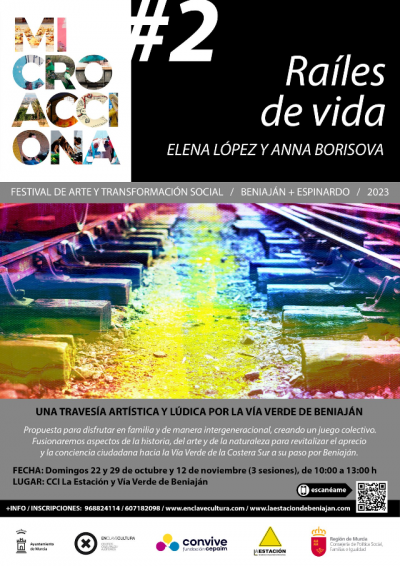
Promotional Video of Rails of Life EnClave Cultura - Ayto. de Murcia
Rails of life is a community-based, intergenerational art project awarded at the 2023 Microacciona Festival of Art and Social Transformation, organized by the City Council of Murcia and the Cepaim Foundation. Created by Elena López and Anna Borisova, Life Tracks emerges as an innovative paradigm within the fields of art and social mediation, intertwining history, nature, and community creativity along the South Coastal Greenway (Vía Verde Costera Sur) as it passes through Beniaján, a town in the Region of Murcia, Spain. More extensively, this artistic project explores the transformation of public space into a place for encounter and reflection. Through creative activities and games, the community is invited to connect emotionally with the Greenway, revealing the rich history and culture of the area. Its playful and collaborative methodology fosters participation across all age groups, strengthening community ties. At the La Estación de Beniaján Intercultural Community Center—witness to the area's many transformations—this experience promotes a deeper appreciation of the surrounding nature and of the space as a living entity in constant change. It is a collective journey of discovery and connection with the environment. The proposed objectives of this artistic project are as follows: ‒ To promote historical and cultural awareness. Through a collaborative and interactive game, the project aims to reveal how the old railway line evolved into the current Greenway, and how this transformation has impacted both the local community and the landscape of Beniaján over time. It traces the site's evolution: from a space of transit to a space of encounter, like a living organism that changes, transforms, and will continue to mutate. ‒ To encourage community participation and envision the future. By inviting participants to imagine future creative interventions and improvements to the space, the project fosters a community dialogue about how we wish our environment to evolve. ‒ To recover emotional connections with the place. Particularly focusing on the old train station—now transformed into a community development center—and the former railway tracks converted into a Greenway, the project aspires to strengthen the emotional bonds between the community and these meaningful spaces. ‒ To stimulate interaction with the natural environment. Through quick, creative interventions using natural materials found in the area, the project allows participants to experience the beauty of nature in a personal and meaningful way. ‒ To highlight the importance of reclaiming abandoned urban spaces. The project emphasizes the need to revitalize disused urban areas as a strategy to prevent deterioration and marginalization. ‒ Ultimately, Life Tracks seeks to unite the community through art and education, creating an environment where heritage, innovation, and collective expression converge to forge a more inclusive and sustainable future for Beniaján.
The first session of Rails of Life welcomed 31 registered participants and offered a rich and diverse experience. Activities were designed for both adults and children/teenagers. Young participants created a collective painting expressing their expectations and hopes for the future of the Greenway in Beniaján. The initial presentation featured local experts in the history of the area, enriching the historical context of the walk. During the collective exploration of the Greenway, participants engaged with the environment in original and diverse ways: uncovering old structures hidden among the vegetation along the path, discovering the rich local flora and fauna, and sharing anecdotes and historical facts about places visible from the trail. To guide this first walk and demonstrate that it is possible to view the environment in a poetic and creative way, observation booklets were designed and distributed to all participants. These booklets served as a pedagogical tool to facilitate the first collective exploration of the Greenway. Throughout the walk, participants engaged—sometimes collectively, sometimes individually—in different exercises and games from the booklet, allowing them to interact with the environment in innovative and reflective ways. This enriched the walking experience and fostered a deeper understanding of the history, culture, and nature of the area.
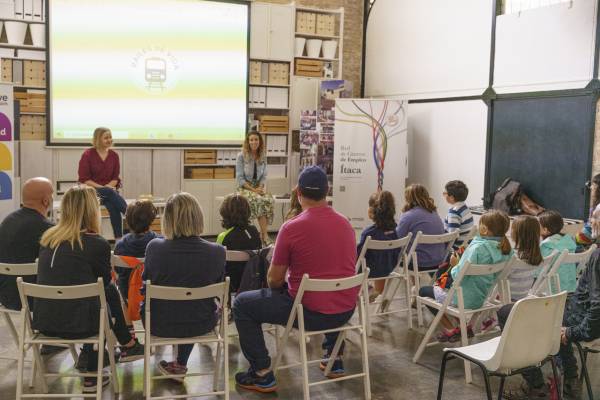
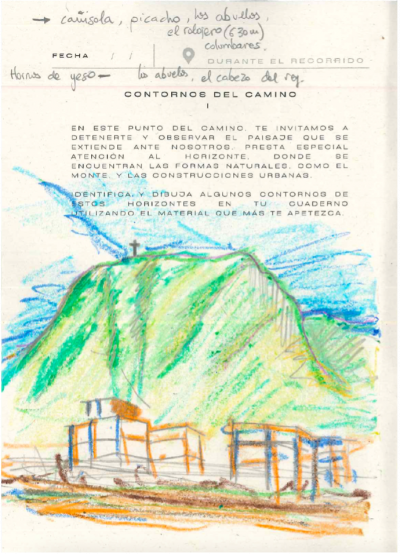
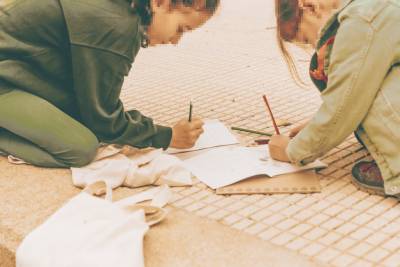
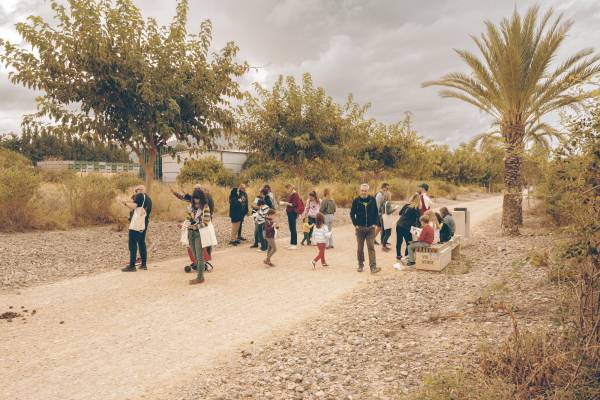
A week later, during a second session at the Community Center, we gathered to discuss and reflect on the previous experience. The goal of this working session was to collectively design an open-access game, enabling any user of the South Coastal Greenway to learn how to develop an alternative way of observing their surroundings. By the end of the meeting, more than forty ideas had been collected for possible themes and exercises to be carried out along the Greenway, enriching the game's design process and laying the groundwork for future creative and reflective activities within the Rails of Life project.
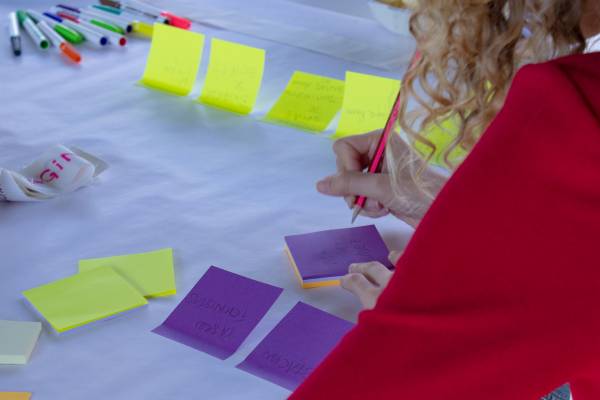
Based on the ideas generated during the second session, the game titled Desvelarí was designed. **Desvelarí**. Composed of 71 cards, the game includes 66 activities divided into three groups of 22, organized by theme around the past, present, or future. The game is available in both a printed and an open-access digital version. During the third session, participants took a walk along the South Coastal Greenway, following the instructions and challenges proposed by the new game. Along the way, they not only enjoyed the experience but also reflected critically on the activities, engaging in exercises of analysis and self-evaluation. In this regard, the session allowed us to assess the functionality of the proposed design. We observed that, due to the variety and openness of the challenges, the game is adaptable to all ages. Moreover, the format is lightweight and convenient, allowing participants to select the activities they wish to complete based on their individual interests.
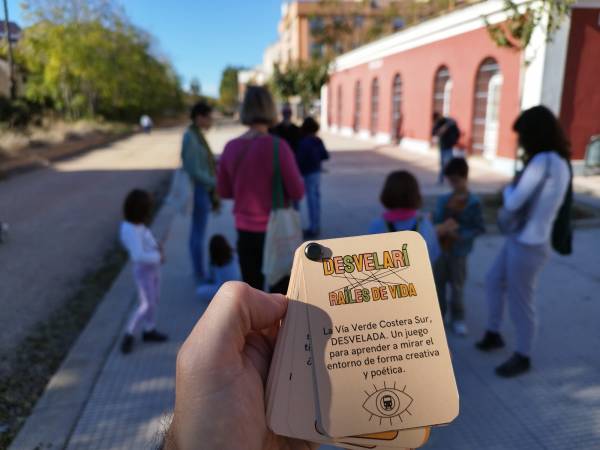
The artistic game Desvelarí also benefits from the support and collaboration of VÍAS VERDES (Spanish Railways Foundation, Ministry of Transport and Sustainable Mobility). Thanks to this collaboration, in May 2024 we participated in the 24th Edition of the National Greenways Day organized by the Foundation. This participation was carried out under the framework of a Research and Knowledge Transfer Contract with the Murcia City Council (Code: 2JBP5-0ZTPR-P0F0W), aimed at producing printed editions of the Desvelarí game and organizing artistic implementation workshops at Monteazahar Primary School and Beniaján Secondary School (IES Beniaján), with 3rd-grade Primary students and 2nd-year Secondary students, respectively.




- rails_of_life.txt
- Última modificación: 2025/04/27 14:28
- por elena.lopez5@um.es